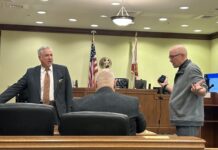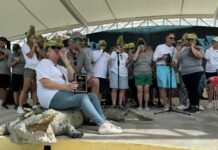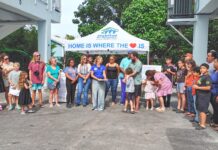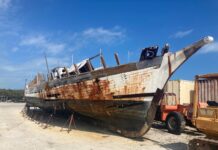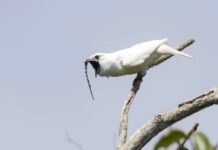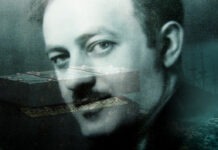
The Key West Extension of Henry Flagler’s Florida East Coast Railway was never the successful enterprise he imagined. For all the money and the effort required to build the Over-Sea Railroad (the project required 11 or so years to complete), it only rambled and steamed across the island chain for 23 years.
1929 was the beginning of the end for the Key West Extension. The combination one-two punch landed with the arrival of Seatrain Lines Inc. and the Great Depression. Seatrain offered railroad car ferry service between New Orleans and Havana at a better price than its competition — including Henry Flagler’s railroad ferry operating between Key West and Havana.
The Great Depression began in 1929, too. When it did, competition between the F.E.C. and Seatrain only intensified. As a result, the shipping between Havana and Key West through the Florida East Coast Railway system substantially dwindled. Because the Key West Extension of Henry Flagler’s railroad was struggling financially, by 1932, it had been placed into receivership.
The final and definitive nail hammered into the coffin of Flagler’s Folly – what skeptics called his plan during the construction of the Key West Extension – arrived in late August 1935.
It started on Thursday, Aug. 29, 1935, when a relatively nondescript tropical disturbance was identified circulating east of the central Bahamas.
The disturbance churned over the warm Atlantic waters toward Andros Island as a slow-moving tropical storm. It was initially projected to pass between Key West and the Dry Tortugas. The initial projection was wrong. By Sunday, Sept. 1, the Category 1 hurricane with 84 mph winds was swirling about 200 miles from the Upper Keys. At 7 p.m., the Category 2 hurricane had sustained winds of 104 mph. It had also begun to turn.
Because of work projects undertaken by the Federal Emergency Relief Administration, which included the building of a series of automobile bridges between Lower Matecumbe Key and Big Pine Key, hundreds of World War I veterans were brought to the Keys and housed in work camps on Windley and Lower Matecumbe Keys.
At 3:30 a.m., someone from the Weather Bureau called the Matecumbe Hotel on Upper Matecumbe Key to relay a message to the F.E.R.A. officials in charge of the camps: “Caution high tides and gales on Florida Keys.”
Work camp officials learned of the Weather Bureau report at 7:30 a.m. A reporter for the Miami Daily News called to inquire about the government’s plan to evacuate the veterans and was told that two trains in Miami could reach the Keys on three or four hours’ notice.
One of the Sunday morning headlines in the Washington Post read: “Hurricane Heads Toward Florida.” The reporting caused enough concern for officials in Washington to reach out to the work camps to ensure evacuation plans were in place, and they were told “yes.”
By 10:30 a.m. Monday morning, Labor Day, the Weather Bureau had issued hurricane warnings for Key West. Ray Sheldon, one of the men in charge of the works camps in the Keys, had a plan but needed to run it by his boss, Fred Ghent, for approval.
One of the problems was that it was a holiday weekend. Ghent rolled out of bed around 11 a.m., checked in with his office, and headed out for what turned out to be a long lunch. No one in his office was aware of where he went, and it was not until 1:45 p.m. that he was contacted and told that the vets needed to be evacuated.
Ghent assured Sheldon that he would take care of it, and, at about 2 p.m., he called the F.E.C. train dispatcher to order a train sent to the Keys. Again, it was a holiday weekend. The process took time, and by the time locomotive engine number 447 was up to steam and coupled to six passenger cars, three baggage cars, and a pair of boxcars, it was 4:25 p.m. Almost immediately, the train was stopped by a drawbridge, allowing boat traffic to pass, and was idle for 10 minutes. It was not the last delay.
At 5:15 p.m., when the train steamed into Homestead, it stopped to load telephone wires and allow a repair crew to board. Also while at Homestead, the decision was made to turn the engine around and make the run to Islamorada in reverse.
Locomotive engine 447 rolled out of Homestead at 5:30 p.m. The train rocked and rolled over the 18-Mile Stretch, over Jewfish Creek, and down the Keys. It arrived at Windley Key, at Camp 1, at 6:50 p.m. When the engine’s pistons began to thrust down, and the train moved forward, the wheels became entangled with a cable that had fallen across the railroad tracks. It took more than an hour to untangle it and free the train.
The relief train arrived at the Islamorada Depot, 2.7 miles away from the Camp 1 site, at approximately 8:10 p.m. Shortly after, screaming winds blew over one of the 75-ton boxcars coupled to the train. A reporter for the Miami Daily News, William Johns, who was aboard the train, later wrote: “We had been stopped but 10 or 15 minutes when a wall of water from 15 to 20 feet high picks up our coaches and swirls them about like straws.”
The 1935 Labor Day Hurricane remains the most powerful storm ever to make a North American landfall. Forces associated with the Category 5 storm destroyed 40 miles of railroad tracks that were never repaired. Because the Key West Extension of the Florida East Coast Railway was bankrupt, the right-of-way was sold to the state of Florida for $640,000, making Sept. 2, 1935, the last day Henry Flagler’s train shook, rattled and rolled over the island chain.


